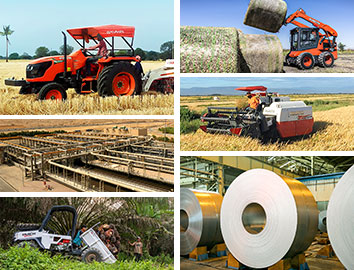Kubota Engines Aim for a Clean Environment and a Better Life
Engines
"High Performance," "Energy Efficient," "Labor Saving." These are the fundamentals that rank as the Kubota Engine Division's greatest advantages, and can be found in all processes from research and development to design and manufacturing. Of course our engines excel in efficiency and energy-saving. But Kubota sets its ideal in total-performance engines with the compatibility and clean emissions that demonstrate our concern for their users and the environment. Our quest continues toward the best possible engine quality with the ideal balance of ecology and technology.
Protecting both the environment and people's livelihoods
Engines are used in automobiles as well as the tractors, combines, mini excavators, and other machinery manufactured by Kubota. But on top of these, our engines are also used in generators and compressors, delivering the power that makes people's lifestyles possible. On the other hand, it's a fact that the impact of air pollutants discharged from engines is a major concern throughout the world. Engine manufacturers must meet emissions standards that are becoming more and more stringent year after year. Kubota has made protecting both the environment and people's livelihoods its mission as it continues its day-to-day development and manufacturing of engines.
Exceeding performance limits through an electronics and chemistry-based approach
What distinguishes Kubota's research and development from other engine manufacturers is the team of specialists from a broad range of fields, including mechanics, electronics, chemistry, and physics, that works to develop our products.
This team has enabled Kubota to overcome barriers of environmental regulations insurmountable with mechanical technology alone by harnessing the power of science. Such regulations are an inevitable part of engine development. In the past, we complied with European emissions standards up to Stage IIIA by improving our engines' mechanical performance.
However, the Stage IIIB regulations enacted in 2012 call for an even further reduction of particulate matter (PM), and mechanical performance improvements alone would not allow us to meet their requirements. This called for innovations in areas other than mechanics, and we responded by adopting a Common Rail System, which electronically controls fuel injection amounts and timing to promote complete combustion, as well as installation of a Diesel Particulate Filter (DPF) and Diesel Oxidation Catalyst (DOC) to reduce PM in emissions.
Kubota developed its own exclusive treatment devices and optimized them for its engines to efficiently filter emissions. The result of these filters is a greater than 92% reduction in PM over Stage IIIA engines not outfitted with DPF and DOC.
By taking our engines that once focused on mechanical technology and packing them with the wisdom of scientific technology that harnesses the power of electronics and chemistry, we have taken our innovation to a whole new level.
Outstanding product variety demonstrates our quest to meet worldwide needs
One of the key advantages of Kubota engines is the wide-ranging product lineup we offer. The trigger for this was the forklifts we designed for North America and Europe. In the past, diesel engines had already made inroads in the forklift market, but with gasoline, LPG, and natural gas, forklifts were typically outfitted with larger automobile engines. Kubota took the initiative in developing gasoline/natural gas engines based on the diesel design and with the same size and reliability as diesel for forklift models from the Super Mini to the V3 series.
Today, based on the “one source, multiple solutions” philosophy, Kubota engines come in a fuel-flexible lineup that can easily support diesel, gasoline, natural gas, and LPG — and they offer a horsepower range no other manufacturer can match.
We have listened closely to each and every user's needs and worked to respond to their demands. The results are the industry-leading adaptability that Kubota engines offer.
Engine development pushes on with a “starting from scratch” mindset
With EU Stage V standards going into effect over 2019 to 2020, environmental regulations will become even more stringent. Kubota will combine the engine technologies we have built over the years with know-how from electronics, chemistry and other fields to pass any and all standards and keep delivering true performance to all users.
To enter the market for the large-scale dry-field farming that has become the world's mainstream method of agriculture, Kubota's tractor business will expand into larger, higher-horsepower tractors. This means that engines will also have to move into a new realm of research and development. Making high-power, large engines doesn't mean simply increasing the size of smaller engines. It requires all new methods of development that can respond to stricter regulations and other new challenges that emerge with size. Retaining the essence of our company's legacy while starting from scratch in terms of drive and enthusiasm in research, we at Kubota will never cease in our efforts.











